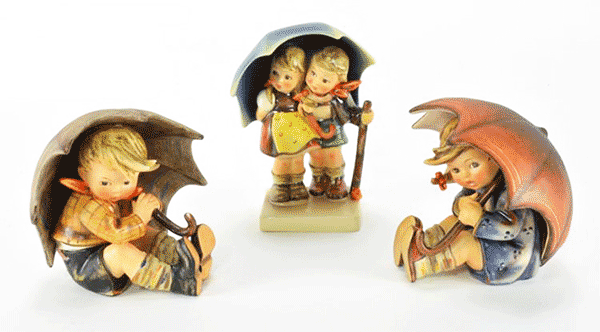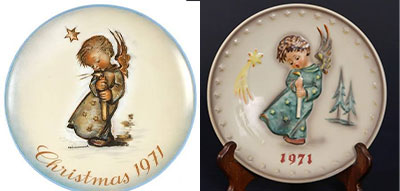
When you hear the name Hummel, you might instantly think of the Hummel Figurines produced by Goebel. Or you might be thinking of the late, world-renowned artist, Sister Maria Innocentia Hummel, who was known for her iconic drawings of children that perfectly encapsulated their innocence and wonder.
So who is Berta Hummel? Why is she sometimes referred to as Sister Berta Hummel? and most importantly, why do the pieces attributed to her have the same art style as Sister M.I. Hummel?
Contents
Who Was Berta Hummel?
Before she was known as Sister Maria Innocentia Hummel, Sister Hummel was born Berta Hummel on May 21st, 1909. That’s right, Berta Hummel and Sister M.I. Hummel, are one and the same.
In 1931, following the uprising of the fanatical Nazi regime, Berta Hummel found refuge behind the walls of the convent of Siessen at Saulgau. Here she dedicated her life to the service of God and passed on her artistic skills to the kindergarten children that were under her care. These very children would go on to act as the inspiration for the very art style that has caught the attention of so many collectors, all over the world.
We cover the life and history of Sister Maria Innocentia Hummel, and how the Hummel name became such an iconic name in the collector world, in our article The History of Hummel.
Why Are Artworks Attributed to Either Berta Hummel or Sister M.I. Hummel?

Even though Berta Hummel and Sister M.I. Hummel was the same person; her artworks were signed by the name that she was using at the time of its creation. This is one of the main reasons why you can find pieces that have been inspired by either name. Well, that and legal constraints that had been created as a result of exclusive rights and who had ownership of the various artworks.
Up until 1934, all of her artworks were signed “B.Hummel”. It was after this point in time that she was ordained. By taking her vows with the Sisters of the Third Order of St. Francis, she devoted herself to living the life of a Nun and adopted her new name, Sister Maria Innocentia Hummel.
Who Owns the Artworks of Berta Hummel and Sister Maria Innocentia Hummel?
There is a difference between having ownership of the artwork itself and having the right to use the artwork. The artworks that were produced and signed “M.I. Hummel”, are owned by the Convent of Siessen. The artworks that were produced and signed by “B.Hummel”, were owned by her surviving family members, following her untimely death, in 1946.
Who actually holds the rights to use these artworks, and how they can be used, is a little more complicated.
Who Holds the Rights to the Artworks of Berta and Sister Maria Inoccentia Hummel?
When we are talking about who holds the rights to the artworks, we first need to define which form of the artwork we are talking about.
The holder of the worldwide rights to the original 2D artworks that are attributed to both Berta Hummel and Sister Maria Inoccentia Hummel, is the Swiss international licensing company, ARS AG.
In 1933, ARS AG, formally known as the Ars Sacra Josef Mueller Verlag publishing company, was renowned for its religious arts and books. They were the first company to produce products that were based on the artworks of Berta Hummel. They used thirty-seven different Hummel pictures to publish postcard motifs, communion souvenirs, and merit pictures for students. Through their dealings with the sisters at the Convent of Siessen, they were given exclusive rights to use the arts that were signed “B.Hummel” and “M.I. Hummel”, for the production of printed 2D products.
In 1935, Franz Goebel was given exclusive rights to have his family business, the German porcelain company, Goebel, produce 3-dimensional products that were inspired by the original artworks of Sister Maria Innocentia Hummel. Even though the company was given the right to have their own artists and master sculptors use the original artworks as inspiration for their own designs; they were still required to have the pieces preapproved by the Artistic Board from the Convent of Siessen, and Sister M.I. Hummel herself, before production could begin.
Following her death in 1946, ownership of her earlier works was given back to her family. Due to preexisting contractual agreements with the ARS AG company, they were not able to permit the 2-dimensional reproductions of the artworks of Berta Hummel so easily. But they were able to issue licenses for the production and reproduction of other 3-dimensional products. Goebel was not given the exclusive rights to the artworks that were made before Sister M.I. Hummel was ordained, only the artworks that she made afterward.
What Are Hummels?

The term “Hummel” has been given to a collection of porcelain figurines that were first produced by the Goebel company in 1935. Since then, it has become more of a brand name for a series of collectible products, who’s designs have all been inspired by the original artworks of Sister M.I. Hummel.
Each piece that has been released by the Goebel company, has been given its own unique Hummel Number (Hum Num) identification. These Hum Nums allow collectors to quickly identify a piece, and thanks to specific trademarks, they can determine the authenticity and year of production of the piece.
As Goebel expanded its range of Hummel collections, the term Hummel is now used to describe the different types of products that the Goebel company has released over the years. No longer is the term “Hummel” simply limited to just figurines. Now there are plates, plaques, candlestick holders and even Christmas Ornaments to name a few.
Are Pieces Accredited to Berta Hummel True Hummels?
The main reason why you find pieces that were inspired by Berta Hummel, being labeled as a Sister Berta Hummel, or Berta Hummel product, has a lot to do with copyright laws and licensing agreements. Yet this doesn’t change the fact that the same artist is responsible for producing all of the works of art that have served as the inspiration for all of these designs.
The fact that the name “Hummel” has appeared on many of these different products that have been produced by various companies; has lead to a lot of confusion among collectors over the years. The validity of all of these “Hummel” pieces, has continued to remain a hotly contested subject among many collectors, even to this day.
In truth, what makes a Hummel inspired product a “True” Hummel, comes down to your own personal tastes, and opinions.
Is it the Artist or the Company that Defines a Hummel?

When collecting “Hummels”, each collector needs to ask themselves, are they collecting pieces from the Goebel Hummel Brand collection, or are they collecting pieces that have been inspired by the original artist.
If the former, then no, Berta Hummel pieces are not Hummels. For collectors like this, a Hummel is a porcelain figurine or product, that has been designed and produced by the Goebel company, and has been issued an authentic Hum Num.
It is the quality of the piece, be it the finish, the material, or the overall design that they are collecting. Even though they may like the art style that the pieces draw their inspiration from, Sister Maria Innocentia Hummel the artist is not the reason for their interest in the collections.
If the answer is the latter, then no matter who is producing the piece, these collectors are only interested in pieces that have drawn inspiration from the original artworks of the artist, regardless of if it was signed “B.Hummel”, or “M.I Hummel”. To them, a Hummel piece is defined by the art style of the original artist, with the manufacture being a secondary feature. Collections like this may even attach the manufactures name to the piece, such as the obvious Goebel, and the lesser-known Schmid Pieces, ARS Sacra Dublers, or Beswick Pieces.
Final Thoughts
If you ever see the name Berta attached to a Hummel piece, it is a sure thing that you have either a reproduction or a piece that has been inspired by the earlier works of Berta Hummel. For more information on determining if the Hummel you are looking at is a genuine Goebel Hummel or an aftermarket piece, please have a read of our article that covers Hummel fakes, forgeries, and reproductions.
When it comes to collecting, there are two different types of collectors, the investor who chases a profit, with little to no emotional investment in what they are collecting; and the fan.
If you like the look of the Goebel produced Hummel inspired collections, then, by all means, focus your attention on the Goebel collections that draw your eye.
But if it is the art style of the pieces that you like, keep an open mind and have a willingness to look at the pieces that have been produced by other manufacturers. Who knows, you just might find a series or collection that you’ll fall in love with.
Hi trying to find a price on a couple of hummels I have..actually I have a huge box full left by my grandmother.Some are so old I can’t read the numbers..one is the volunteers,and couple angels numberHX262 and think its number 25 its a Angel keeled down and little girl in her bed…Where else can I look up prices for my hummels.Thank you for your time.
My name is Melissa. I work estate sales and I came across a sketch that I thought my grandmother would love so I bought it. Unfortunately, my grandmother died so I ended up keeping the original sketch.
Now that I have done a little research on it, I’m led to believe that the artwork is done by none other than Ms. Hummel herself.
So I am wondering if I can get this piece authenticated or appraised.
Can anyone help me ?
Use Hummel in the subject line if response is by email.
Thanks in advance.